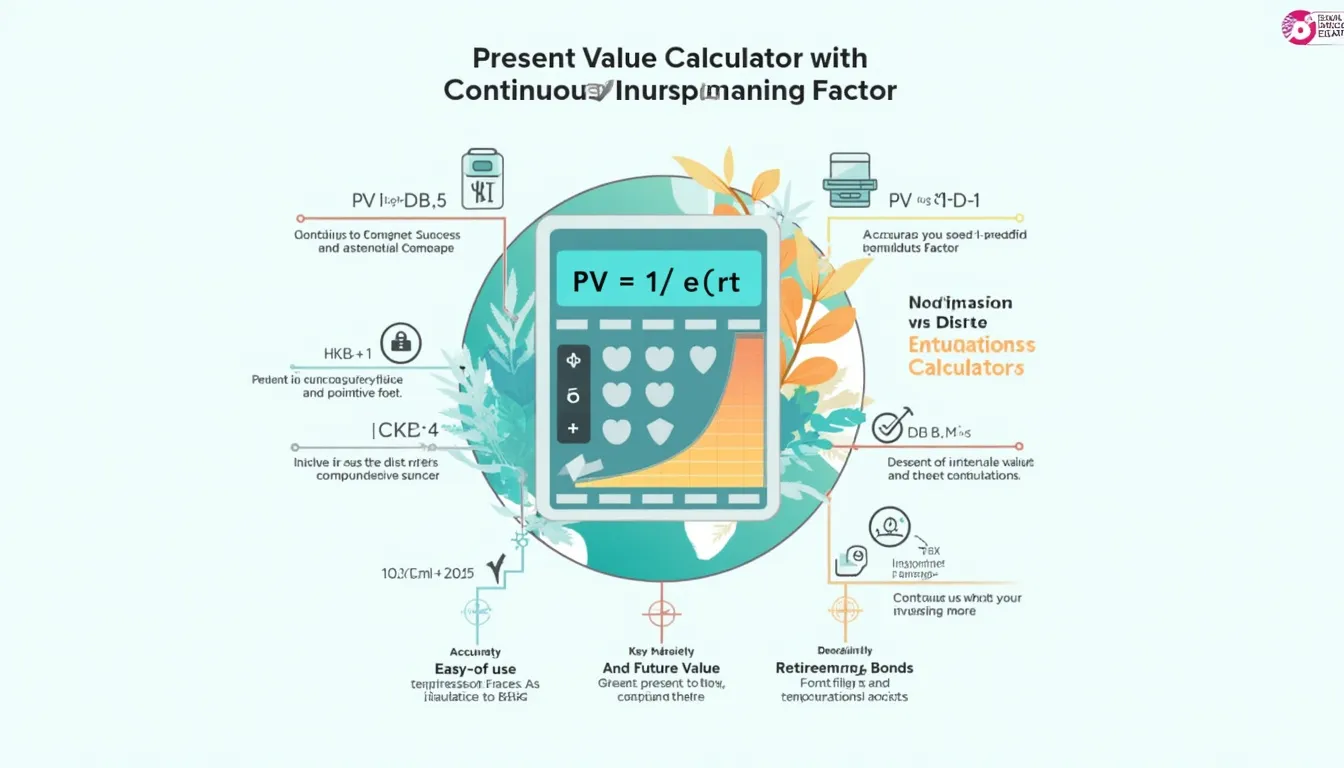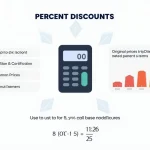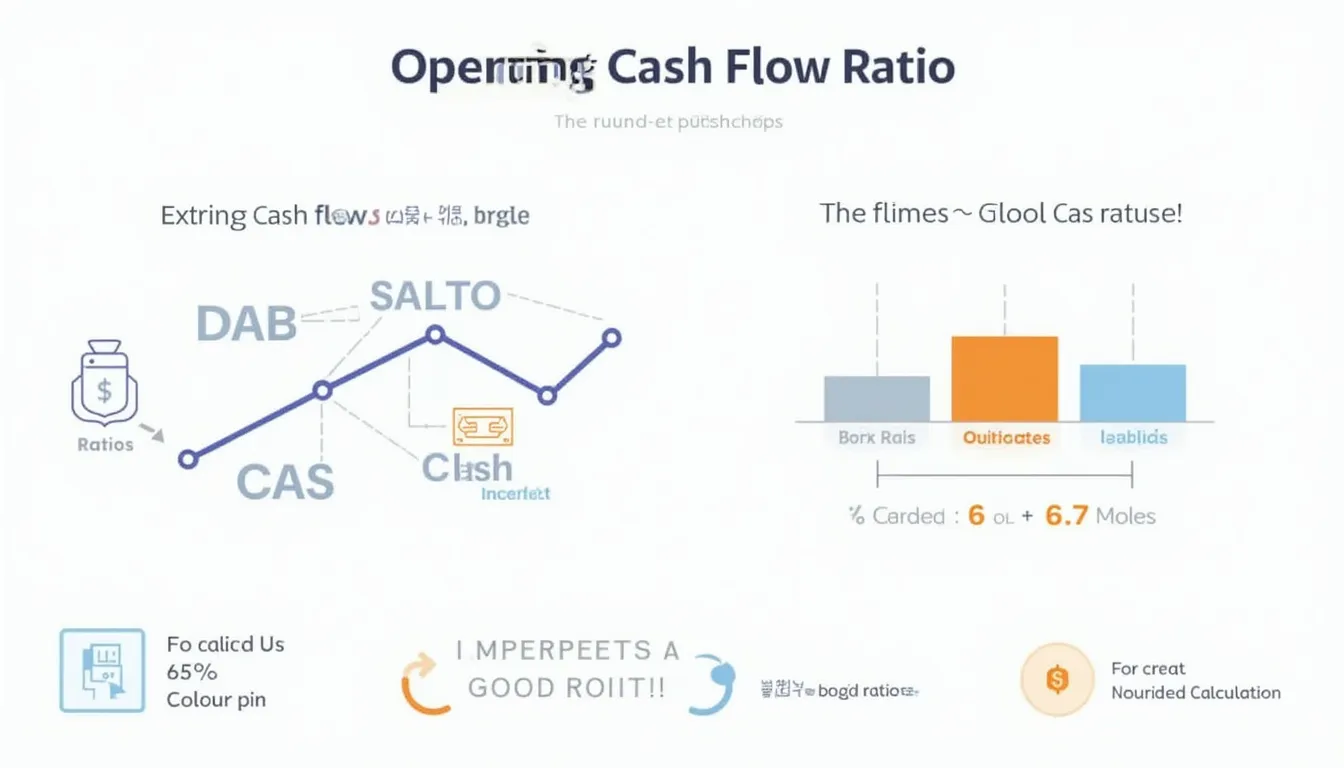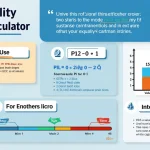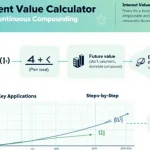Present Value - Continuous Compounding Factor Calculator
Is this tool helpful?
How to use the tool
- Enter the annual rate (%): type, for example, 3.75 or 8.20.
- Enter time (years): type 2.5 or 0.75 to include partial years.
- Click “Calculate”: the tool shows the discount factor to four decimals.
- Find present value: multiply the factor by any future cash flow.
Formula used
The calculator applies the continuous-compounding present-value factor:
$$PV_{CCF}= rac{1}{e^{rt}}$$- r = annual rate (decimal)
- t = years
Example A
- r = 3.75 % ⇒ 0.0375; t = 2.5
- Exponent: 0.0375 × 2.5 = 0.09375
- Factor: 1/ e0.09375 = 0.9106
- $5 000 × 0.9106 = $4 553
Example B
- r = 8.20 % ⇒ 0.082; t = 0.75
- Exponent: 0.0615
- Factor: 1/ e0.0615 = 0.9403
- $1 200 × 0.9403 = $1 128
Quick-Facts
- e ≈ 2.71828, defined by $$\lim_{n→∞}(1+1/n)^n$$ (NIST, 2019).
- Continuous compounding yields 0.012 % more than daily compounding at 5 % for one year (Investopedia, 2023).
- Present value halves when $$t= rac{\ln2}{r}$$—≈ 9.9 years at 7 % (CFA Institute, 2020).
- Black–Scholes assumes continuous compounding for risk-free rates (Black & Scholes, 1973).
- Federal Reserve prime rate ranged 3.25 %–8.5 % from 2010-2023 (FRB, 2023).
FAQ
What is continuous compounding?
Continuous compounding adds interest at every instant, giving a growth factor of $$e^{rt}$$ for principal $1 (Investopedia, 2023).
Why convert future cash flows to present value?
You compare investments on the same date and incorporate the opportunity cost of capital (CFA Institute, 2020).
How do I switch to a future-value factor?
Take the reciprocal: $$FV\;factor = e^{rt}$$, the mirror of the discount factor (Hull, 2022).
Which rate range is realistic for valuation?
Corporate analysts commonly model 2 %–12 % real rates depending on risk (Damodaran, 2023).
Does continuous compounding overstate returns?
No; it represents the limit as periods shorten and is only marginally above daily compounding—≈0.012 % at 5 % (Investopedia, 2023).
Where is the method used in practice?
Option pricing, swap valuation and risk-neutral discounting all embed continuous rates (Black & Scholes, 1973).
Can the rate be negative?
Yes; European government bonds traded near –0.5 % in 2020 (ECB, 2021). The formula still works.
How precise is the constant e?
“For engineering, 15 decimal digits of e ensure micro-unit accuracy” (NIST Handbook 100, 2019).
Important Disclaimer
The calculations, results, and content provided by our tools are not guaranteed to be accurate, complete, or reliable. Users are responsible for verifying and interpreting the results. Our content and tools may contain errors, biases, or inconsistencies. We reserve the right to save inputs and outputs from our tools for the purposes of error debugging, bias identification, and performance improvement. External companies providing AI models used in our tools may also save and process data in accordance with their own policies. By using our tools, you consent to this data collection and processing. We reserve the right to limit the usage of our tools based on current usability factors. By using our tools, you acknowledge that you have read, understood, and agreed to this disclaimer. You accept the inherent risks and limitations associated with the use of our tools and services.
